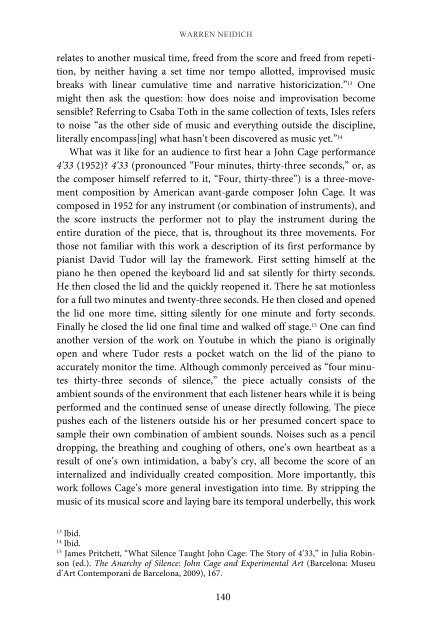Foucault, Biopolitics, and Governmentality
Foucault, Biopolitics, and Governmentality
Foucault, Biopolitics, and Governmentality
Create successful ePaper yourself
Turn your PDF publications into a flip-book with our unique Google optimized e-Paper software.
WARREN NEIDICH<br />
relates to another musical time, freed from the score <strong>and</strong> freed from repetition,<br />
by neither having a set time nor tempo allotted, improvised music<br />
breaks with linear cumulative time <strong>and</strong> narrative historicization.” 13 One<br />
might then ask the question: how does noise <strong>and</strong> improvisation become<br />
sensible? Referring to Csaba Toth in the same collection of texts, Isles refers<br />
to noise “as the other side of music <strong>and</strong> everything outside the discipline,<br />
literally encompass[ing] what hasn’t been discovered as music yet.” 14<br />
What was it like for an audience to first hear a John Cage performance<br />
4'33 (1952)? 4'33 (pronounced “Four minutes, thirty-three seconds,” or, as<br />
the composer himself referred to it, “Four, thirty-three”) is a three-movement<br />
composition by American avant-garde composer John Cage. It was<br />
composed in 1952 for any instrument (or combination of instruments), <strong>and</strong><br />
the score instructs the performer not to play the instrument during the<br />
entire duration of the piece, that is, throughout its three movements. For<br />
those not familiar with this work a description of its first performance by<br />
pianist David Tudor will lay the framework. First setting himself at the<br />
piano he then opened the keyboard lid <strong>and</strong> sat silently for thirty seconds.<br />
He then closed the lid <strong>and</strong> the quickly reopened it. There he sat motionless<br />
for a full two minutes <strong>and</strong> twenty-three seconds. He then closed <strong>and</strong> opened<br />
the lid one more time, sitting silently for one minute <strong>and</strong> forty seconds.<br />
Finally he closed the lid one final time <strong>and</strong> walked off stage. 15 One can find<br />
another version of the work on Youtube in which the piano is originally<br />
open <strong>and</strong> where Tudor rests a pocket watch on the lid of the piano to<br />
accurately monitor the time. Although commonly perceived as “four minutes<br />
thirty-three seconds of silence,” the piece actually consists of the<br />
ambient sounds of the environment that each listener hears while it is being<br />
performed <strong>and</strong> the continued sense of unease directly following. The piece<br />
pushes each of the listeners outside his or her presumed concert space to<br />
sample their own combination of ambient sounds. Noises such as a pencil<br />
dropping, the breathing <strong>and</strong> coughing of others, one’s own heartbeat as a<br />
result of one’s own intimidation, a baby’s cry, all become the score of an<br />
internalized <strong>and</strong> individually created composition. More importantly, this<br />
work follows Cage’s more general investigation into time. By stripping the<br />
music of its musical score <strong>and</strong> laying bare its temporal underbelly, this work<br />
13 Ibid.<br />
14 Ibid.<br />
15 James Pritchett, “What Silence Taught John Cage: The Story of 4’33,” in Julia Robinson<br />
(ed.). The Anarchy of Silence: John Cage <strong>and</strong> Experimental Art (Barcelona: Museu<br />
d’Art Contemporani de Barcelona, 2009), 167.<br />
140


